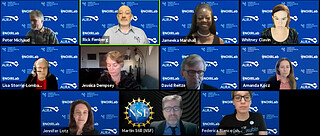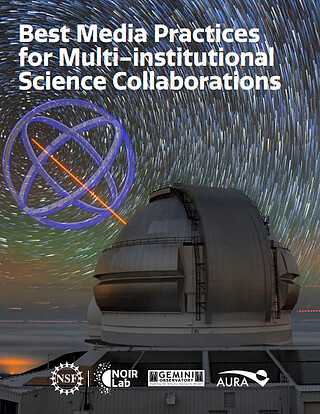Science Writer’s Workshop: Multi-Messenger & Time-Domain Astronomy
Friday, 08 January 2021 3 p.m. — 7 p.m. MST
Your time:

Online event
Science Writer’s Workshop: Multi-Messenger & Time-Domain Astronomy
On Friday, 8 January 2021, journalists and other communications professionals participated in a virtual workshop on multi-messenger astronomy (MMA) and time-domain astronomy (TDA). The workshop was held as part of the 237th meeting of the American Astronomical Society (AAS) and ran from 12:00 pm to 4:00 pm EST (17:00 to 21:00 GMT/UTC).
Featuring presentations by several leaders in the fields of multi-messenger and time-domain astronomy, the workshop was offered jointly by NSF’s NOIRLab and the AAS Press Office. Funding was provided by the National Science Foundation through Gemini Observatory’s Gemini in the Era of Multi-Messenger Astronomy (GEMMA) program.
Over the past decade or so, discoveries have been made with “messengers” from space that go beyond photons, the messenger of light: particles from distant galaxies, neutrinos from the Sun and supernovae, and most recently ripples in the fabric of spacetime itself, known as gravitational waves. At the same time, a growing realization of the importance of the universe’s dynamic nature has crept into astronomy: supernovae explode, stars change in brightness, novae flare, and outbursts occur in regions around black holes. Multi-messenger and time-domain astronomy are two of the most rapidly advancing areas of astronomy, and it is expected that over the next decade and beyond these disciplines will define modern astronomy.
The key objective of the workshop was to provide a glimpse into the future of multi-messenger and time-domain astronomy and the facilities that will drive these fields. Additionally, there was a discussion about the challenges of communicating multi-messenger and time-domain astronomy in the context of a forthcoming white paper on best practices in large-scale, multi-institutional communication in the field.
Watch the YouTube Video of the Workshop
Most of the following presentation titles link to the speakers' presentation slides, either as PDFs or on Slides.com. These slides are provided for science writers' personal use only. If you wish to publish or otherwise reproduce any of the content in these presentations, you must obtain permission from the presenters — otherwise you may be in violation of copyright law. If you need help contacting a presenter, email AAS Press Officer Rick Fienberg.
Agenda
- Rick Fienberg, American Astronomical Society: Welcome
- Peter Michaud, NSF’s NOIRLab, Introductions and Context
- Martin Still, National Science Foundation: Welcome from NSF and Overview of MMA/TDA
- Jennifer Lotz, Director, Gemini Observatory, NSF’s NOIRLab: Multi-Messenger and Time-Domain Astronomy and the Role of Gemini and GEMMA
- David Reitze, Executive Director, LIGO Observatory: LIGO and Its Historical and Future Role in Multi-Messenger and Gravitational-Wave Science
- Federica Bianco, Professor of Physics and Astronomy & Public Policy and Administration, University of Delaware, Rubin Observatory: Vera C. Rubin Observatory: Ushering a New Era of Time-Domain Astronomy
- Lisa Storrie-Lombardi, Director, Las Cumbres Observatory: The AEON Network and Multi-Messenger and Time-Domain Astronomy
- Jessica Dempsey, Deputy Director, East Asian Observatory: Event Horizon Telescope and Communications with Large, Multi-Institutional Collaborations — Lessons Learned
- Whitney Clavin, Senior Content and Media Strategist, Caltech, and Peter Michaud, Education & Engagement Manager, NSF’s NOIRLab: Best Media Practices for Multi-Institutional Science Collaborations — White Paper Discussion
